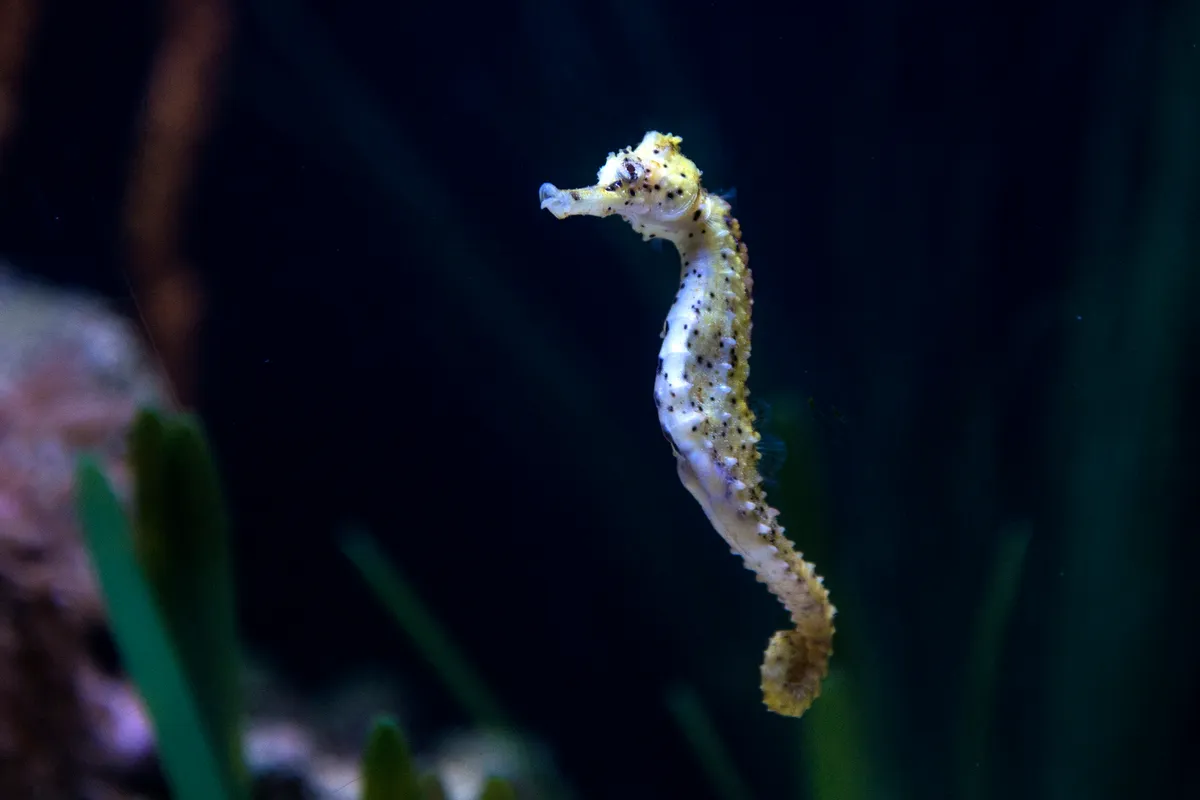Seahorses are odd-looking creatures, says Neil Garrick-Maidment, founder of The Seahorse Trust. With their horse-like heads and snake-like tails, these marine wonders are unlike any other animal – more akin to a mythical beast or something from a child’s drawing. And the translation of the scientific name, ‘horse sea monster’, only makes them more intriguing. The more you learn, the more you fall under their spell.
What is a seahorse?
A seahorse is a true fish, with a swim bladder, fins and all the normal ‘fishy things’, but unlike other fish, it swims upright, has a prehensile tail and instead of scales it has skin covered in mucous.
It can also change colour and has a long, elongated snout for reaching out to catch and suck in prey. Strangely, the Victorians thought the seahorse was an insect because it has a hard skeleton, just under the surface of the skin, that makes it look as if it has an armour-plated body.
Why is the seahorse so-called?
Its name describes the way it looks, with its horse-like head, and the scientific name, Hippocampus, derives from horse (hippos) and sea monster (kampos).
How many species of seahorse are there?
In Britain’s coastal waters there are two species of seahorse, the spiny (Hippocampus guttulatus) and the short-snouted (Hippocampus hippocampus). The spiny is often wrongly called the long-snouted seahorse. Around the rest of the world it’s thought there are about 65 species, depending on how they’re classified, but species are being discovered all the time as new regions of the ocean are explored.
How big are seahorses?
Seahorses vary in length, starting at 1.5cm from the top of the crown (coronet) to the end of the tail, going right up to the largest seahorse ever recorded – a 34cm-long spiny seahorse found off the Dorset coastline.
Usually, spiny seahorse adults measure 16-22cm, so this was quite big, though two others, measuring 30cm and 28cm, were found at the same time as this whopper. It shows that if left alone, seahorses can grow to a large size.
Which habitats do seahorses prefer?

They are found in a wide range of habitats, from seagrass beds to coral reefs, and even in human-made areas such as marinas and harbours. Though all seahorses have the same basic shape, they’re all cleverly adapted to their habitat. Some have spines (cirri) growing on their bodies that make them appear more weed-like, some have knobs to make them look like sea fans, and others are smooth and rely on colour change to make them ‘disappear’.
How long do seahorses live?
Seahorses grow rapidly when they are first born and then the growth slows down as they become adults. However, they never stop growing, so large individuals are often quite elderly, in seahorse terms. Spiny seahorses live to at least 12 years old but small pygmy seahorses only live for one or two years.
What do seahorses eat?
Seahorses have voracious appetites because they do not have a true stomach, just a tube – a digestive tract that runs from the mouth to the anus. This tube absorbs some of the food, but because it is not very efficient, seahorses consume vast amounts for their size. An adult eats 70-plus shrimp per day and fry (babies) eat up to 3,000 pieces of plankton per day.
Why do seahorses change colour?
Seahorses changes colour in two ways. First, they have a base colour that changes to reflect the colour of the habitat they are in. So, in seagrass surroundings they would be green; in a coral reef they would change to brighter hues. Seahorses that live on sand are often sandy coloured with small black dots. The second colour change is emotionally activated, as seen in chameleons and cuttlefish. During a courtship display, for example, seahorses can go from black to white. Emotion-led colour change takes seconds, while base colour change can take some time.
How do seahorses reproduce?
Seahorses have a beautiful and elaborate courtship display, with the male circling in a shimmering dance around the female. When they reach the climax, they rise in the water column and face each other. When this happens, the female puts her ovipositor into the male and deposits her eggs.
The male then drifts down to the seabed, wriggling as he self-fertilises the eggs in his brood pouch. Once pregnant, he sits and rests for the gestation period (28 days in large seahorses and 14 days in smaller ones), giving birth after contractions that can last up to 12 hours.
What are the biggest threats that seahorses face?
Without a doubt the biggest threat is from humans. Every year, up to 150 million seahorses are lost when they are caught for use in illegal activities, such as the curio, medicine and aquarium trades. This is unsustainable and unless this exploitation is stopped, and the pollution of the seas and destruction of habitat is halted, seahorses will be functionally extinct within the next 25 to 30 years.
Neil Garrick-Maidment, executive director and founder of The Seahorse Trust